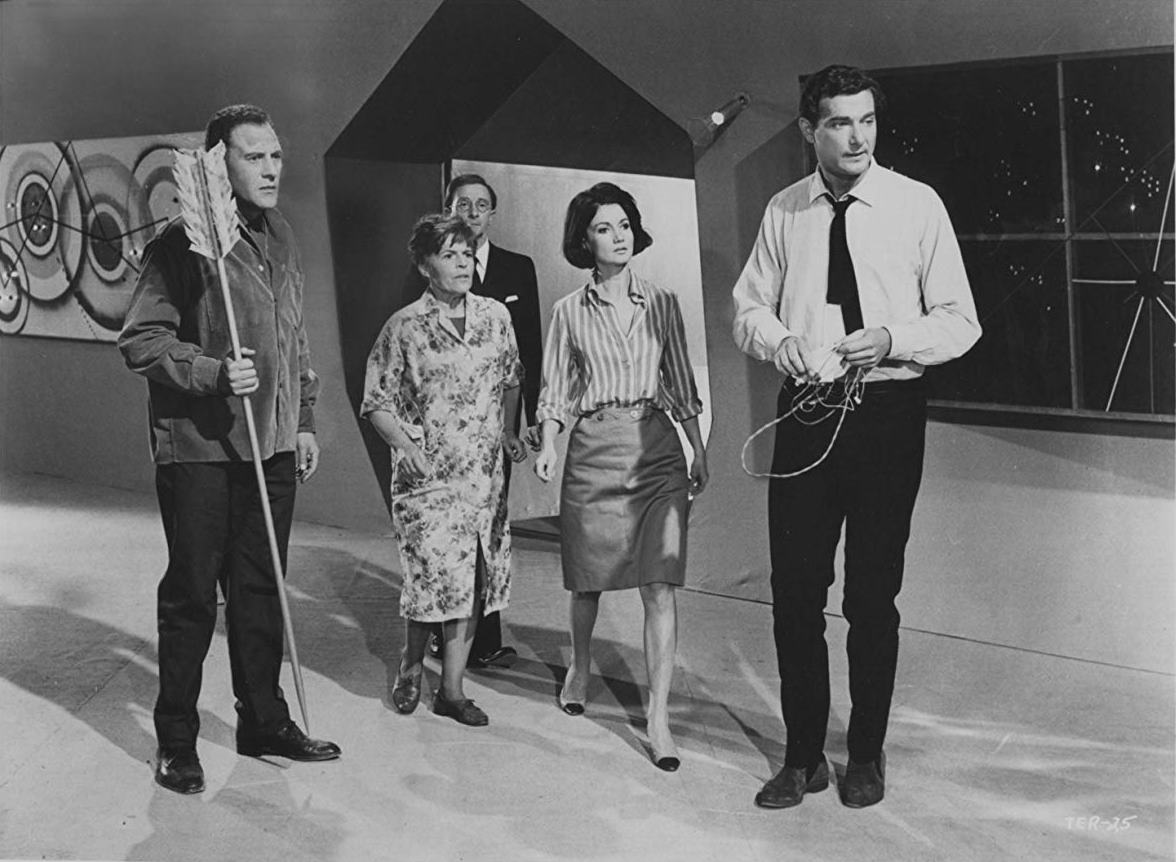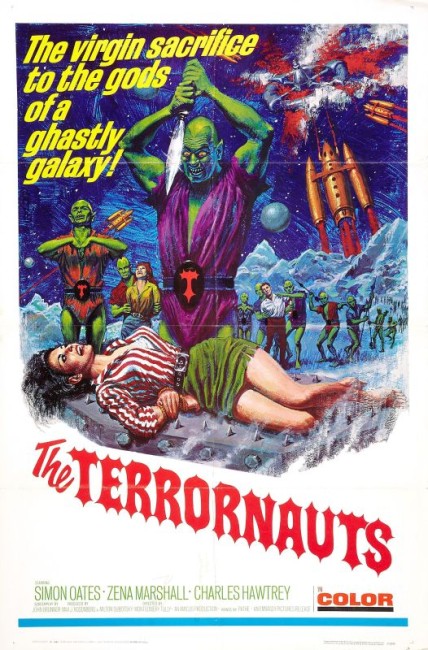Crew
Director – Montgomery Tully, Screenplay – John Brunner, Based on the The Wailing Asteroid by Murray Leinster, Producers – Max J. Rosenberg & Milton Subotsky, Photography – Geoffrey Faithfull, Music – Elisabeth Lutyens, Special Effects Models – Ernest Fletcher, Special Effects & Model Photography – Bowie Films Ltd., Production Design – Bill Constable. Production Company – Amicus
Cast
Simon Oates (Dr Joe Burke), Zena Marshall (Sandy Lund), Charles Hawtrey (Joshua Yellowlees), Stanley Meadows (Ben Keller), Patricia Hayes (Mrs Jones), Max Adrian (Dr Henry Shore), Richard Carpenter (Danny), Leonard Cracknell (Nick)
Plot
Astronomer Joe Burke heads Project Startalk, which uses a radio telescope to search the stars for communication from alien species. The project has so far failed to produce any results and the observatory head Henry Shore wants it shut down. Just then, they pick up a radio signal coming from the direction of the asteroid known as Schule’s Object. Burke purchases equipment that can convert the telescope to broadcast a signal back to the source. Upon receiving it, the robot that maintains the base on the asteroid despatches a ship to Earth and snatches up the observatory, along with Burke, his assistant Ben Keller, secretary Sandy Lund, the officious accountant Joshua Yellowlees and tea lady Mrs Jones. They are carried off back to the asteroid base. There the robot seems to want them to perform a series of tasks to test their intelligence.
Amicus Productions was a small British studio that emerged in the 1960s, formed by producers Milton Subotsky and Max J. Rosenberg. Amicus quickly became the most successful of the imitators that rode the coattails of the English horror boom that had been created in the late 1950s by Hammer Films. Amicus’s staple soon became the anthology horror film starting with Dr Terror’s House of Horrors (1965) and passing through the likes of Torture Garden (1967), The House That Dripped Blood (1970), Asylum (1972), Tales from the Crypt (1972), The Vault of Horror (1973) and From Beyond the Grave (1974).
In between the other odd full-length horror film, even a Harold Pinter adaptation The Birthday Party (1968), Amicus also made a number of ventures into the British science-fiction film, most notably two films adapted from the tv series Doctor Who (1963-89, 2005– ) starring Peter Cushing with Dr Who and the Daleks (1965) and Daleks Invasion Earth 2150 A.D. (1966), as well as the alien invasion film They Came from Beyond Space (1967) and The Mind of Mr. Soames (1969) featuring Terence Stamp as a man with the mind of a child. Towards the end of their run, they also made the first two films in a trilogy of Edgar Rice Burroughs adaptations with The Land That Time Forgot (1974) and At the Earth’s Core (1976).
The Terrornauts has a bad movie reputation today – surprisingly it was one film that Mystery Science Theater 3000 (1988-99, 2017-8) never managed to get their deplorable claws into. That said, there are some surprisingly respectable elements to the film. For one, it has a screenplay by John Brunner, one of the most celebrated British writers to emerge from the British science-fiction New Wave of the 1960s (the same movement that also produced Michael Moorcock and J.G. Ballard), the author of classic works such as Stand on Zanzibar (1968), The Sheep Look Up (1972) and The Shockwave Rider (1975). The film is adapted from The Wailing Asteroid (1960) an original novel by Murray Leinster, a pulp novelist between the 1940s and 60s who wrote much in the way of space opera. The director was Montgomery Tully, who had mostly directed an output of British thrillers and whose only other genre entries were Escapement/The Electronic Monster (1960) about the programming of dreams and the single British entry into the Communist threat genre with Battle Beneath the Earth (1967).

I am not as quick to dismiss The Terrornauts as are some of the other less tolerant genre purveyors who always make a beeline to ridicule bad special effects and/or dialogue. John Brunner’s script gives the appearance of having at least done some research on how radio astronomy works and deals with realistic matters such as the problems of time lag and orbital inclination. In fact, The Terrornauts could almost act as an early version of Contact (1997) and its story of communications from the stars.
The plot set-up reminds of This Island Earth (1955) with a group of scientists receiving a message from aliens and then being abducted to take part in an alien war. That perhaps and a prefiguring of some of 2001: A Space Odyssey (1968) with humans being guided to a meeting with aliens who help raise their consciousness. That said, The Terrornauts takes the story further than This Island Earth, Contact and 2001 did. While these others were happy to leave the details of the contact vague or as an unfilled tease of something bigger than us, here we see people being placed through a labyrinth to test their intelligence so that they can be recruited to help fight against a force threatening the galaxy. You feel like this is a film that could have had potential if delivered on a much better budget than it was.
Of course, where The Terrornauts fails is in the utter inadequacy of its depiction. Montgomery Tully’s direction is prosaic and plodding. John Brunner tries to add some comic-relief elements with the expedition also managing to include an anally-retentive accountant (Charles Hawtrey) and a tea lady with a broad working class accent (Patricia Hayes) who are played as one-dimensional caricatures. The film starts to fail when it comes to the ridiculous bleeping robot and its wobbling antenna hand and the even sillier appearance of an alien creature threatening them that looks like it is made out of a plastic tarpaulin with eyes glued onto its side and protruding tentacles. The scenes where various of the group are briefly teleported to another planet and Zena Marshall is nearly dragged off to be sacrificed at the hands of alien natives with green-painted skin feels as though it has strayed in from an episode of Lost in Space (1965-8). The intelligence-raising machines look like the rather silly image of the cast sitting around wearing bathing caps that have coloured wires attached on their heads. Perhaps the worst part of the film is the cheap and incredibly poorly photographed model effects. The most pitiful aspect is the space war that climaxes the film – the model of the space station is seen rocking on a wire in space as it comes under attack while all of the invading alien ships hang on wires and then explode in flames.

